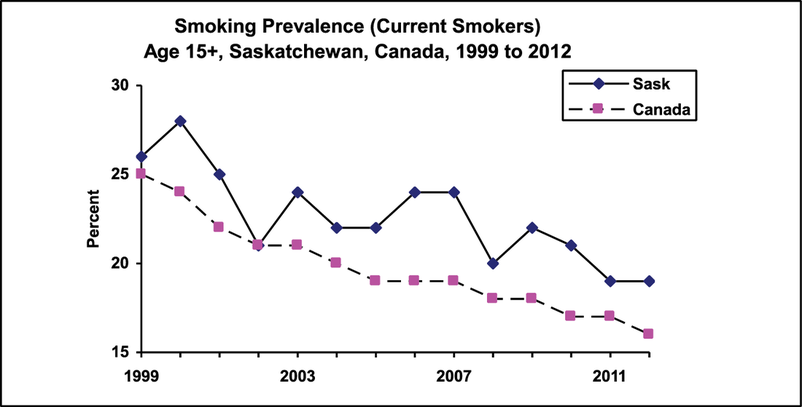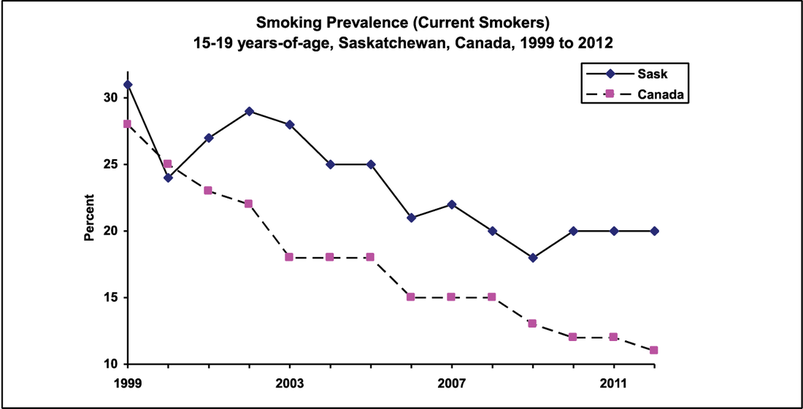Tobacco use is the leading preventable cause of disease and death in Saskatchewan and Canada.
Tobacco use and exposure to second hand smoke are responsible for over 1,500 Saskatchewan deaths annually, accounts for 18% of Saskatchewan deaths. Tobacco kills half its long-term users, more than all murders, alcohol-related deaths, car accidents and suicides combined. Uniquely among consumer products, tobacco has no safe level of use. For every tobacco-related death, there are 20 people living with a tobacco-related disease.
Most tobacco users become addicted in their youth. The nicotine in tobacco is one of the most addictive substances known. About eight out of ten who try smoking get hooked and half of long term smokers die prematurely. Deaths due to tobacco-related causes are entirely preventable.
Economic Costs
Tobacco also places an enormous economic burden on the province and its taxpayers. A 2009 study shows the full cost of tobacco use in Saskatchewan is an estimated $1.08 billion ($2008) or $1,063 per capita per year. This represents direct health care costs of $167.6 million as well as indirect costs. Only 18% is offset by tobacco tax revenue.
Tobacco Reduction Efforts In Saskatchewan
In 1999,Saskatchewan took comprehensive steps to protect youth and all residents from tobacco-related death and disease with the formation of an All Party Committee on Tobacco Control. Since then, Saskatchewan has adopted many effective measures, also known as ‘best practices’ in tobacco reduction, including:
The results have been impressive. Saskatchewan’s smoking prevalence has decreased from 28% in 2000 to 19% in 2012. This decrease in smoking
prevalence can be translated into the saving of many lives and a reduction in diseases and health care costs.
Tobacco use and exposure to second hand smoke are responsible for over 1,500 Saskatchewan deaths annually, accounts for 18% of Saskatchewan deaths. Tobacco kills half its long-term users, more than all murders, alcohol-related deaths, car accidents and suicides combined. Uniquely among consumer products, tobacco has no safe level of use. For every tobacco-related death, there are 20 people living with a tobacco-related disease.
Most tobacco users become addicted in their youth. The nicotine in tobacco is one of the most addictive substances known. About eight out of ten who try smoking get hooked and half of long term smokers die prematurely. Deaths due to tobacco-related causes are entirely preventable.
Economic Costs
Tobacco also places an enormous economic burden on the province and its taxpayers. A 2009 study shows the full cost of tobacco use in Saskatchewan is an estimated $1.08 billion ($2008) or $1,063 per capita per year. This represents direct health care costs of $167.6 million as well as indirect costs. Only 18% is offset by tobacco tax revenue.
Tobacco Reduction Efforts In Saskatchewan
In 1999,Saskatchewan took comprehensive steps to protect youth and all residents from tobacco-related death and disease with the formation of an All Party Committee on Tobacco Control. Since then, Saskatchewan has adopted many effective measures, also known as ‘best practices’ in tobacco reduction, including:
- Smoke-free public places
- Ban of retail tobacco displays
- Smoke-free workplaces
- Increased regulation of tax-exempt tobacco sales
- No outdoor signs promoting tobacco
- No tobacco sales in pharmacies
- No tobacco use on school grounds
- Smoke-free zone entrances of public buildings
- Smoke-free common areas of apartments and condos
- Smoke-free vehicles when children under 16 years of age are present
The results have been impressive. Saskatchewan’s smoking prevalence has decreased from 28% in 2000 to 19% in 2012. This decrease in smoking
prevalence can be translated into the saving of many lives and a reduction in diseases and health care costs.
However, Saskatchewan’s youth smoking rate is among the highest in Canada. Saskatchewan has been very successful in
introducing healthy public policies.
introducing healthy public policies.


